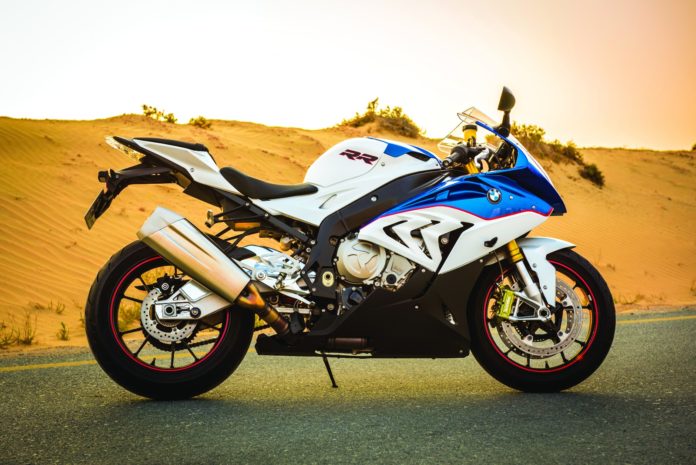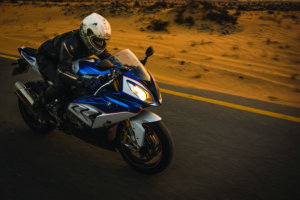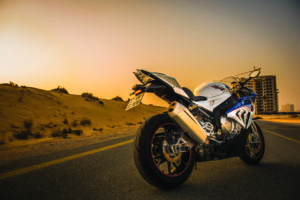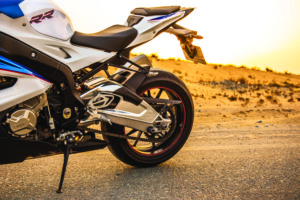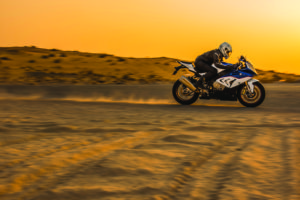Let’s be honest, till 2009, BMW Motorrad was known for its tourers and the legendary R1200GS. The audacity of BMW’s arrival on the superbike scene took the whole motorcycling world by surprise. Today, seven years after the original S1000RR left every other super-sports bike manufacturer reeling, we’ve got our hands on the second generation of this fearsome litre-class monster.
Let’s get some facts straight right from the start. None of us here at Bike Nation Magazine are crazy enough to ride a race bike with licence plates, which is what the S1000RR is. But when AGMC BMW invited us to take the S1000RR for spin, we couldn’t refuse.
The S1000RR began its life as a homologation special back in 2009 when BMW had to satisfy WSBK requirements. It offered looks unlike any other litre-class motorcycle out there and compared to its conservative Japanese counterparts, the S1000RR’s design seemed outlandish. Fast-forward to the current generation, which received major upgrades in 2015, and a minor refresh now for 2017, the S1000RR still remains one of the most ferocious sportsbike ever made. However, BMW Motorrad claims to have paid particular attention in designing the bike to be even more rider-friendly, whether it is used for everyday riding, flitting through bends on country roads or being put through its paces on the racetrack.
For the road, the power on the S1000RR does seem excessive and to be honest, it is. It is nothing but a track machine. The enhanced performance of the new RR in terms of drive power can be attributed to the re-engineered cylinder head with new duct geometry, new intake camshaft and even lighter intake valves. Furthermore, an airbox with a modified capacity combines with an intake system with shorter intake lengths to make mixture preparation more effective than ever and gives S1000RR added punch.
Another key contributing factor to the improvement in power and torque characteristics is the new exhaust system, which now dispenses with a front silencer and weighs around three kilograms lighter. Rideability and response from standstill both benefit from an increase in torque upwards of 5,000 rpm, a more linear torque curve, as well as a wide torque plateau that allows the rider to summon up almost maximum pulling power between 9,500 and 12,000 rpm.
As a factory-fitted option, the new S 1000 RR can also be specified with the new improved version of the electronically controlled Dynamic Damping Control (DDC) suspension. It gets three riding modes as standard and to be honest, even the most toned down ‘rain’ mode offers enough power.
The S1000RR’s sophisticated electronics gives the rider lots of control and confidence. HP4-derived traction control and anti-wheelie are smoother and there’s an optional ‘user’ riding mode, for you to mix and match your preferred electronics settings.
In “Rain” mode, output is 187 hp which was previously set at 163 hp, while torque is limited to a maximum of 108 Nm. In “Sport” mode you get the full bangers 199 hp on tap, at the same time as providing direct throttle response, just like in the “Race” mode. This riding mode has been developed for use on winding roads in particular. In this setting, the ASC or DTC traction control systems intervene later in view of the much more favourable grip conditions, allowing the rider to safely power out of bends for maximum riding pleasure out on the road.
The “Race” mode, meanwhile, has been specially devised for use on racetracks as well as winding roads offering perfect grip conditions. Here once again, the rider can enjoy full engine power combined with direct throttle response. The Automatic Stability Control continues to be set up for road operation. However, because it factors in the data on banking angle, the optional Dynamic Traction Control is more geared towards riding on the limit, allowing it to accommodate an extremely sporty riding style.
The centrepiece of the chassis continues to be an aluminium bridge frame that is welded together from four individual cast pieces, with the engine tilted forward at an angle of 32 degrees. Forks and rear shock are revised, but you can opt for the semi-active (DDC) system, first seen on the now discontinued HP4.
After a full day of riding and two full gas tanks later, I realised one thing. It’s not so much how much more powerful, faster and better handling the new S1000RR is, it’s how easy it is to manage. BMW seem to have achieved the principal development objective for the new S1000RR, which was to further improve on its predecessor’s already outstanding power and torque figures and combine this with enhanced rideability for superb all-round performance.
Photography: Laura Huntley


